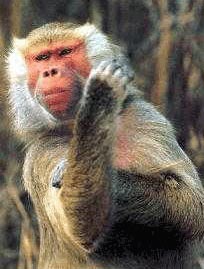Researchers at the Yerkes National Primate Research Center, Emory University, have found bonobos and chimpanzees use manual gestures of their hands, feet and limbs more flexibly than they do facial expressions and vocalizations, further supporting the evolution of human language began with gestures as the gestural origin hypothesis of language suggests.
 Now we know where we got it from.
Now we know where we got it from.
Working with two groups of bonobos (13 animals) and two groups of chimpanzees (34 animals), Yerkes researchers Amy Pollick, PhD, and Frans de Waal, PhD, distinguished 31 manual gestures and 18 facial/vocal signals.